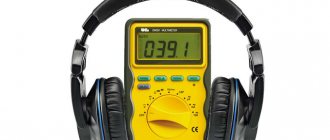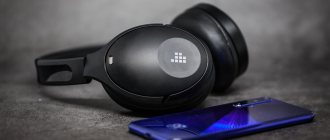Headphones are an extremely important accessory that everyone probably has. They will be needed to listen to music, watch movies or any other media files that are accompanied by an audio track. With their help, you can listen to anything without distracting or embarrassing others. Headphones can be connected to a huge number of household appliances: computer, TV, telephone, and so on. But when choosing them you should be very careful so as not to be disappointed with the result. An important role is played by such a parameter as the sensitivity of the headphones. What is it and how to choose the ideal model for yourself? You will learn about all this in this article.
Sensitivity
Everyone has encountered a situation where some headphones sound louder than others, even though the level on the player (or smartphone) is set the same. This fact is often associated with the difference in headphone power. But headphones are not an amplifier; this premise is fundamentally wrong.
In fact, how loud the headphones will sound depends on their sensitivity. Traditionally, this parameter lies in the range of 90–120 dB, and for most models available on the market this range is already 95–105 dB. Sensitivity shows how loud the headphones will play, all other things being equal. The higher it is, the higher the maximum volume and the less load on the built-in amplifier of the player or smartphone. I noticed another direct relationship: the cheaper the headphones, the less likely it is that their real (and not indicated in the technical data sheet) sensitivity will be high.
Headphones AKG K 315. Sensitivity - 126 dB, impedance - 32 Ohms, maximum input power - 15 mW.
Equipment: not always good
For wired headphones, a detachable cable is desirable, as on the Noontech Hammo S: if damage is detected, it can be easily replaced. You can also connect longer cords or twisted cable. Most devices fold, making them easy to transport. But not all headphones come with a cover or case to protect them from dust and dirt.
In order not to remove the headphones every time the phone rings, most models have built-in microphones with control buttons. Of the Bluetooth headphones, only the Sony MDR-ZX330BT model is deprived of these pleasures. Philips SHB9850NC provide a noise reduction function, which, however, only imposes constant background noise, which can interfere with listening to quiet tracks, and cause headaches for sensitive people.
Power
But when it comes to power, you shouldn’t chase watts. Especially when the main source of music is a smartphone or portable player. With high sensitivity, a few milliwatts are enough for the music to play loudly, and the gadget’s amplifier is not overloaded and uses up battery power sparingly. Yes, if you choose headphones with high power, the sound will probably (just maybe) be solid and punchy. But this will not last as long as you would like - the gadget’s battery will begin to discharge rapidly under such a load. Moreover, there are often cases when the built-in amplifier simply cannot cope with powerful headphones. As a result, you won’t hear a good sound (loose, shallow bass), and you’ll get distortion at volumes above average.
For headphones used at home, high power is no longer a problem, because it is assumed that they will be used with a stationary amplifier. Then high power will contribute to high sound quality.
Beyerdynamic DT 1350 headphones. Sensitivity - 129 dB, impedance - 80 Ohms, maximum input power - 100 mW
Isodynamic and orthodynamic
In pursuit of high-quality loudspeaker sound, in 1973 an application was filed with the US Patent Office for the so-called Hale driver. It is this invention that underlies isodynamic headphones.
The emitted element is a rectangular membrane made of thin Teflon film coated with aluminum in the form of rectangular strips. This complex structure is located between two magnets with a strong magnetic field. The current drives the plate and it is these vibrations that the human ear hears. The advantage of isodynamic headphones is high accuracy and an impressive power reserve (especially relevant in the production of loudspeakers).
A type of Hale emitters are orthodynamic headphones. Their only difference is the use of a round membrane (in isodynamic it is rectangular).
Resistance
Another factor that significantly affects sound quality, energy consumption and generally determines the compatibility of headphones with the amplifier part is impedance. From the point of view of physics, impedance is somewhat different from the more understandable term “resistance,” but from a consumer point of view this is not so important, so it is quite possible to find such writing on the packaging of headphones.
Any amplifier has a certain range of loads with which it is capable of operating optimally. The impedance of the headphones, measured in ohms, accordingly determines the operating mode of the amplifier. Portable equipment usually contains amplifiers designed to operate with an impedance from 16 to 32 ohms. Therefore, these are the numbers you will find in most headphones. However, it is quite acceptable to use headphones with an impedance of 40–60 ohms with portable equipment. The fundamental difference is that the latter will require more power to operate, which means battery consumption will increase. Also remember that if the headphone impedance differs significantly from the recommended one, the amplifier will operate in a “freelance” mode, which may result in distortion and a general decrease in sound quality. And in extreme cases, it will also lead to failure of the amplifier or headphones.
Denon AH-C250 headphones. Sensitivity - 109 dB, impedance - 87 Ohms, maximum input power - 100 mW
High-impedance headphones, whose impedance amounts to hundreds of ohms, should only be used with stationary amplifiers. Most often, high-impedance headphones are made for professional purposes, although they can also be found among expensive high-end models for home use.
Portable amplifier for optimal sound
High impedance headphones provide better sound quality but may be too quiet on portable devices. To prevent this problem from becoming acute, the power of the speakers must match the device. Otherwise, the sound volume will always be unsatisfactory. If you cannot achieve the desired sound by combining headphones with devices, try using a special amplifier.
Selecting headphones with the correct impedance helps the audio device function stably, last a long time and produce sound of fairly satisfactory quality. Good sound is appreciated not only by professionals who work every day in the music field. Any person would be pleased to have a device that produces clear, deep and beautiful sound. Annoying noises, too low a sound, or rapid battery drain can really ruin your mood.
The high impedance of the headphones ensures low current output. Due to this, less energy is consumed and less frequency distortion occurs. The amplitude and frequency characteristics of high-impedance headphones are equalized by working through an amplifier.
To understand what kind of resistance your device sounds like, determine what voltage your device is capable of. Small devices physically cannot create large voltages. A high output voltage is generated by stationary type devices that operate from the mains and not from a battery. Therefore, the impedance of headphones for stationary sound reproduction devices should be higher in order to fully enjoy the capabilities of good technology. However, a good amplifier can control the process of interaction of technical devices, smooth out shortcomings and reveal the potential of devices.
frequency range
The frequency range of headphones is probably the simplest and most understandable value. The wider it is, the better the sound. If the factory settings go beyond the audible range, for example, 5 Hz - 25 kHz, it indicates that the edges of this very audible range will be reproduced without much loss. Maybe because this is a simple value, and even with large numbers, manufacturers tend to embellish it. There are often standard numbers such as 20 Hz - 20 kHz. And no indications about the conditions under which the measurements were made, not to mention the frequency response graph. 20Hz can really be there, but with such a volume that only instruments in a deaf acoustic room, where perhaps (just perhaps) the measurements took place, will hear them.
Sony MDR-1R headphones. Sensitivity - 105 dB, impedance - 48 Ohms, maximum input power - 1500 mW, frequency response - 4-80,000 Hz
Ears versus numbers
In conclusion of the review of the main characteristics, I want to save readers from one common illusion that “headphones with the same passport data sound the same.” Not at all.
With the same frequency range, the same sensitivity, power and impedance, different headphones will most likely play completely different from each other. Since our impression of the sound is formed by the accuracy of the response of the emitter, the shape of the frequency response and a number of other indicators that are published by developers extremely rarely, while others cannot be measured at all. Unfortunately or fortunately, modern measuring instruments have not yet reached those heights when they learn to perceive a musical signal in a complex manner, like a person. Therefore, having studied the characteristics for compatibility with the rest of the equipment set (source, amplifier), weighing their cost against your wallet, you still need to go and listen to them. No other way.
Source
10th place
I detail all the advantages of electrostatic technology over conventional dynamic drivers. In terms of accuracy of reproduction, detail and beauty of sound, nothing can compare with “electrostats”. However, as with the price tags for such solutions. This bundle costs a mind-blowing $1.5K! And we must take into account that we are looking at only a high-quality modern Chinese brand. And not the legendary STAX. This is the sound level that only a few reach. Does this make practical sense? Here everyone decides for himself. But once you hear electrostatic headphones, you don’t want to switch back to “dynamics”. So, dear reader, be careful!
That's all for today. This week the Top discrete (embedded) sound cards will also be published. See you later!
If you find an error, please select a piece of text and press Ctrl+Enter
Determining what it is measured in
It can be different for each device, so it is impossible to determine it exactly.
The quality of this characteristic also depends on the size of the magnetic core. The larger this part, the higher the indicator of the accessories. However, small in-ears, earbuds, and others are unlikely to have large cores. Therefore, they are of lower quality in this regard, compared to, for example, full-size ones.
The volume you hear through an accessory does not always depend on the smartphone itself. From one sound source through different gadgets, sound is perceived differently.
What should be the sensitivity?
Sensitivity, as already mentioned, can be different for each device. However, the differences affect not only companies and models of gadgets, but their types. Let's consider them separately.
In intracanal
In-ear accessories are used to listen to music from a smartphone. The indicator of these gadgets can be anything. In addition, many people do not like loud music, so they choose quiet devices.
The ideal level for in-ear gadgets will be from 90 to 110 dB.
In invoices
There are more requirements for overhead and full-size accessories. They are taken for a more professional sound, to avoid the same effect as in-ear headphones, so volume and quality are more important.
Many overheads have a reading in the range of 100-110 dB. The highest value is determined in different ways and can reach up to 120 dB.
In full size
Full-size gadgets differ from previous ones in that their ear pads completely cover the ears. Professional products are used in full-size form, as they provide excellent sound.
However, the value of this technical characteristic is not always at the very top. They differ little from invoices in this parameter. Therefore, for full-size ones this level can be from 95-105 to 140 dB.
Source
When choosing headphones, you may encounter many technical parameters that characterize sound quality. Power, electrical resistance (impedance), overall dimensions, weight. Among them, the consumer property that stands out is the sound volume or, in technical terms, the sensitivity of the headphones.
CAN HEADPHONES DAMAGE, DECREASE HEARING, or lead to deafness.
A healthy ear can hear 10-15 dB. Whisper is 20 dB, calm conversation is 30-35 dB. Screaming at 60 dB is annoying. Sounds from 90 dB are destructive. And a rock concert at 100-120 dB is traumatic for hearing. This sound can be obtained with headphones. This may damage, reduce hearing, or cause deafness.
Sound above 90 dB destroys cells in the inner ear, in the cochlea, and sensorineural hearing loss occurs.
Scientists around the world have officially proven the harm of headphones. The research was carried out for 10 years and scientists identified hearing diseases that are caused by loud music listened to through headphones.
The negative effect of headphones is harmful to the body; headaches, dizziness, noise, ringing in the head occur. Headphones have a particularly destructive effect on children - they get tired quickly, have difficulty learning, are irritable, have a negative effect on the emotional state, and decreased concentration. Headphones have a negative effect on the brain - headaches, increased cerebral vascular tone, sudden changes in pressure. Pressure builds up in the ear canal, which constantly puts pressure on the eardrum.
When music is played loudly for several minutes, hearing loss will not occur. The body has protection against short loud sounds, but there will be hearing loss with prolonged exposure to loud music. First of all, the perception of low frequencies will deteriorate. A person ceases to distinguish between birdsong, hissing and whistling sounds. First, the perception of low frequencies decreases, then high and hissing sounds. The ears stop hearing the singing of birds and the rustling of leaves.
Technical characteristics, general concepts
Main physical and technical parameters affecting sound quality and volume:
- Reproducible frequency range.
- Impedance (resistance).
- Power.
- Nonlinear distortion (degree of distortion).
- Headphone sensitivity.
Recommendations: 9 Best Vacuum Headphones
What is the best headphone impedance?
, Technical characteristics of good headphones
Range
The human ear mainly perceives a frequency component in the range of 20
20000Hz. Some more, some less, depends on the anatomical features of the auricle and the sensitivity of the hearing organs. With age, the ear recedes, especially at the upper border.
On the other hand, the full spectrum of frequencies is important for people associated with music - composers, sound engineers, artists and music lovers. Such properties are typical for professional or high-quality household products. Spectrum is 5
42000Hz, which allows you to reproduce sound with the highest possible purity.
Resistance
Or impedance, an indicator of the nominal resistance at the headphone input. The full parameter consists of two components, resistive and reactive. The value is directly related to the resonant frequency.
The resistance of the headphone is interconnected with the output parameters of the signal source. That is, portable equipment (smartphone, player, tablet) is limited in terms of output voltage, but is loyal in terms of current level. Therefore, it is advisable to select low-impedance headphones.
Stationary equipment, with a more powerful signal, allows for varying the voltage value. Hence, it is preferable to use high-impedance headphones.
Power indicators
The generalized power rating of headphones is in the range of 1
5000mW. Inconsistency with the parameters of the electrical signal source - exceeding - can lead to failure of the reproducing device.
To obtain high-quality sound from a smartphone or radio player, a few milliwatts are enough. Using higher settings will quickly drain battery power. In addition, the sound will become defective in frequency, and significant signal distortion will occur. Hence, the high sensitivity of the headphones compensates for the seemingly insufficient playback power.
Powerful designs can be safely used with stationary signal sources. The built-in amplifier will provide the required level. The sound will be clear and high quality.
Reference reference level, types
Decibel is a relative value. After all, the level of the electrical signal is measured in different units: dBm (dBmW); dBu; dBV (dBV); dBfs.
Don’t be afraid, when putting together a project you are unlikely to need these unusual units and there is no need to understand their differences. These units are found in the characteristics of audio equipment and are of interest, first of all, to engineers who need this data to coordinate equipment.
If there are so many measurement options, then how can we correctly measure the real physical quantities of volts, watts, etc. This is why we need a reference (reference) level.
Let's give an example. Historically, a power value of 1 milliwatt at a load of 600 Ohms was taken as the reference level. And the voltage value is:
U= 0.001*600 = 0.6 = 0.775 V, where
P=1 mW - power;
R=600 Ohm - resistance.
In measurement practice, the following reference (reference) levels are used:
- dBu is a reference voltage of 0.775 V, corresponding to a power of 1 mW into a 600 Ohm load. For example, the standardized signal level for professional audio equipment is +4 dBu, i.e. 1.23 V;
- dBV (Russian designation dBV; the designation dBm (dBm) is also found - a reference voltage of 1 V at a rated load (for household appliances, usually 47 kOhm). For example, the standardized signal level for household audio equipment is –10 dBV;
- dBfs - the reference voltage corresponds to the full scale of the device. For example: “recording level is –6dBfs”; with analog-to-digital conversion for linear digital code, each digit corresponds to 6 dB and the maximum possible recording level is 0 dBfs;
- dBA, dBB, dBC, dBD - reference levels are selected based on the frequency characteristics of the “weighting filters” in accordance with the “equal loudness curves”.
The most common electrical signal levels are:
- Standard “zero” level 0dB=0.775V;
- Another frequently encountered level is +4dB=1.23V;
- In professional equipment +6dB=1.55V;
- In household equipment -10dB=0.25V (250 millivolts)
Selecting headphones by sensitivity
Sound volume is necessary for a more complete perception of the entire frequency range and the ability to hear the sound signal in places with increased external noise - metro, tram, busy highways, etc. In addition to the technical capabilities of the headphones, it is necessary to take into account the signal source. The most common:
- Telephone (smartphone).
- Audio player.
- Personal Computer.
- TV.
Headphones for smartphone
The gadget is compact in size. Accordingly, the dimensions of the headphones and the technical capabilities of the device must be adapted to each other in terms of power. An additional clarification is that a headset can be selected for a mobile phone to enable conversation over the telephone line.
Therefore, sensitivity is determined by the purpose of the headphones. Either for conducting conversations over mobile communications, or combining them with listening to music. The speech quality may be the same, but the music signal will be limited. Hence, you should pay attention to the indicators given by the manufacturer in the accompanying documentation.
5 Best Gaming Headphones with Mic
Headphones for player
Typically, the player is offered complete with headphones. But, with excellent characteristics of the signal source, the playback device may not transmit the entire range of the audio signal and have unsatisfactory sensitivity.
Optimal design - liners (vacuum) with a power of up to 40 mW. For a powerful (in terms of power source) player, on-ear headphones with an output of 300 mW or more are suitable. Good sound quality will provide sensitivity within 100dB. Resistance range 16
32 Ohm is no longer required - the sound quality will remain the same.
Computer
For a personal device, headphones are selected for playing electronic games and listening to music. Type – overhead or full-size (monitor). Frequency range not less than 20
20000Hz. Sensitivity from 100dB and above. Power over 300 mW. But it is not recommended to turn it on at full volume. Otherwise, you can quickly plant a rumor.
How to connect headphones to TV
TV
The signal source is a stationary device, therefore, the headphone power can be increased to 600
800mW and above. Resistance no more than 64 Ohm. The most convenient ones are overhead or full-size types. In addition to listening to films, educational programs, they are used to watch music programs. Hence, the frequency range is 20
20000Hz and wider (for music centers), sensitivity not lower than 100dB.
Standard amplitude units (decibels, dB) in sequencers
In sequencers (digital audio processing programs), the amplitude of an audio signal is usually characterized by its relative level, expressed in decibels (dB).
For example, O dB is not the threshold of audible sound, but a reference point chosen by the application developers based on certain considerations known to them.
A given signal can have a level either less than 0 dB (i.e., a negative level) or above 0 dB. In some applications, 0 dB is the maximum acceptable signal level. In these programs, the displayed signal level is always less than 0 dB. Some have values above 0 dB, for example Cubase ⇓:
Thank you all and good luck in your creativity!
Subscribe to the blog's RSS and stay tuned for new articles.
Summing up
The most optimal sensitivity of headphones is around 100±1%. And it is best for devices connected to mobile signal sources - smartphones and players.
Topic materials: 5 best JBL headphones
5 Best Bone Conduction Headphones
, 6 Best Headphones for Running , 6 Best Studio Headphones , 7 Best Denon Headphones
7 Best In-Ear Headphones
, 8 best armature headphones, 9 best Sennheiser headphones, How to choose headphones for listening to music on your phone and computer
Source











